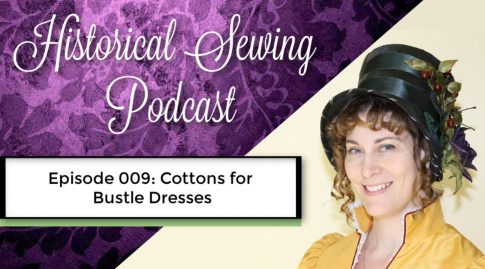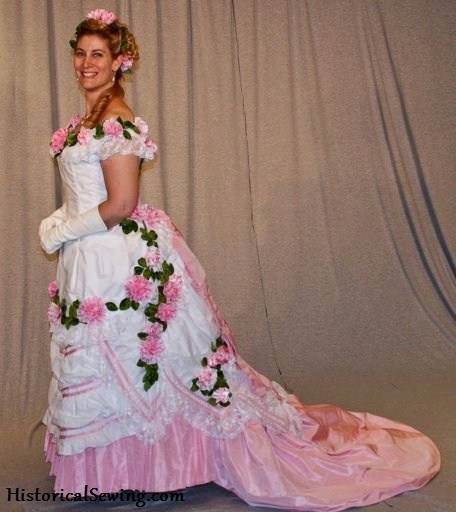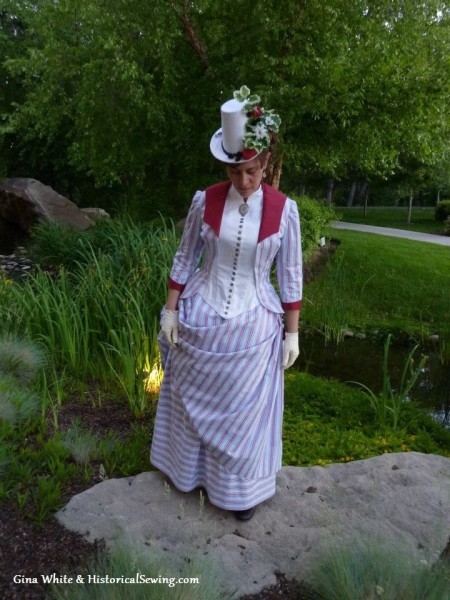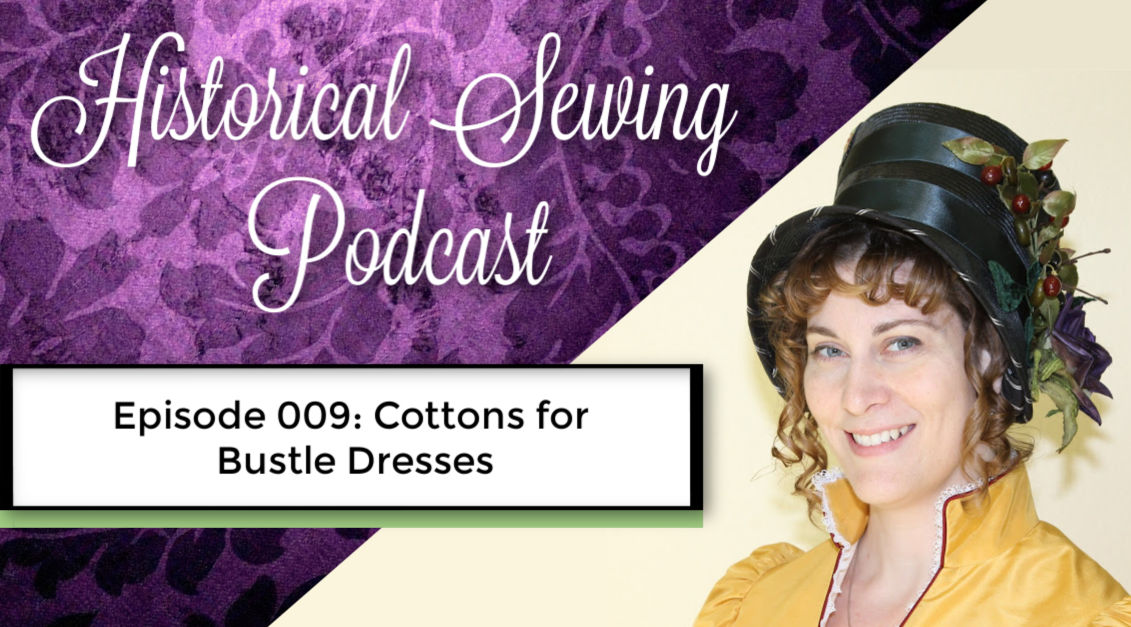
Is cotton historically appropriate to use for Victorian bustle dresses? Enthusiastically -YES! Day and evening wear from the 1870s and 1880s abounds in various cotton weaves used in the late 19th century.
In this episode Jennifer talks about her favorite fabric, cotton, with its wonderful properties of being easy-to-sew, breatheable, washable and with strength and elegance depending on the weave you use.
Show Notes and Mentions
–Cottons for historical costumes blog post
-Museums mentioned: V&A Victoria & Albert Museum, The Metropolitan Museum of Art, LACMA Los Angeles County Museum of Art, and KCI Kyoto Costume Institute
-Jennifer’s Pinterest boards for Bustle Day Dresses and the 1870s-1880s Bustle Era
-Blog post on flatlining skirts in cotton
–Polished cotton called Rain No Stain in the home dec section at Joann Fabrics
-The photo below is my 1876 evening gown reproduction made from cotton Swiss batiste as a substitute for the original “Indian muslin” recommendation.

-My blog post on using cottons for bustle foundation skirts
-Read my blog post on flatlining bodices including cotton weaves/fabrics appropriate for doing so.
-Robert Kaufman (not Robert Allen as I say in the episode) cotton lawn at Hart’s Fabrics (no affiliate) but can be found at other shops if you search.
-Swiss batiste, shirtings and other cotton fabrics from Farmhouse Fabrics (no affiliate)
-This photo below is my 1887 Summer Berry Trifle dress made from cotton shirting fabric.

-Prewash your cottons! Read more about pre-treating in the washing machine here.
–1871 Harvest Grape Dress used as the sample for my Bustle Day Dress Class.
–1880 Dressing Gown in cotton lawn flatlined in cotton muslin.
–1883 Caramel Apple Dress in basic quilting cottons.
-Find Jennifer on Gab: @JenRosbrugh
Episodes are released on Wednesdays. Be sure to subscribe on iTunes or on Stitcher to keep updated on new releases and have first access to new episodes as they are released.
Find the podcast on other platforms by visiting the Podcast page for links.
Contact us by email at sewing@historicalsewing.com or on our Contact Page.


Thank you for all of the information, thoughts and resources you are sharing! I have a question concerning the cotton – how do you deal with wrinkles and cotton wrinkling? Sometimes it’s just enough to sit down to create unwelcoming creases in fabric…any solutons? Thanks 🙂
Solutions, not much as that’s simply the nature of cotton. Anytime it’s worn or used will get wrinkles. Silk taffeta does the same thing. However, unless you are in a place for portraits with a ready steamer I wouldn’t worry too much about wearing a cotton dress as clothing/garment. Although, starching will help in keeping cotton crisp – if your design allows for it. When you get up from sitting smooth and fluff out your skirts to get them out of the “crushed” look. And enjoy wearing cotton!
Are there transcripts, for the hearing impaired?
Currently, no. But for this particular episode you can read my blog post that gives similar information.
I know I can always count on your advice when I’m lost.
Right now I’m considering patterns and fabrics options to sew a bustle dress inspired by the one on “Mary Poppins Returns” and this podcast came right in time. Thank you very much!
You are welcome! Thanks for listening.
I haven’t see the film yet, but the stills I’ve seen of her pink striped bustle look like a delicious costume!
I love cotton! I’ve mostly worked with cotton because I just don’t have the money for silk or wool (to buy it or dry clean it). Quilter’s cotton is my go-to because it is so easy to work with, comes in such vibrant colors and patterns, and is washable. It’s a comforting fabric because I don’t have to think about the fabric when I’m working with it. I’ve worked with heavier cotton twills and corduroy, but I haven’t worked with lightweight cotton fabrics very much. That’s going to change soon because I plan on using voile.
Question: if I flatline netting (the stiffer stuff, not the fine tulle) with the voile, do you think that would give it enough body to use it for a bustled overskirt? I’m not expecting huge poofs here, but I also don’t want it to look like a deflated bustle balloon.
I wouldn’t flatline voile with netting, or even much at all, as voile is generally chosen for its ultra soft drape and sheerness. I’d recommend cotton batiste, organdy or lawn for a bustle skirt over voile. But if you do choose to move forward with the voile, try silk organza as an underlining. Remember: underlining a fabric is to support the fabric best for the structure you need. For more on flatlining skirts read my post here.